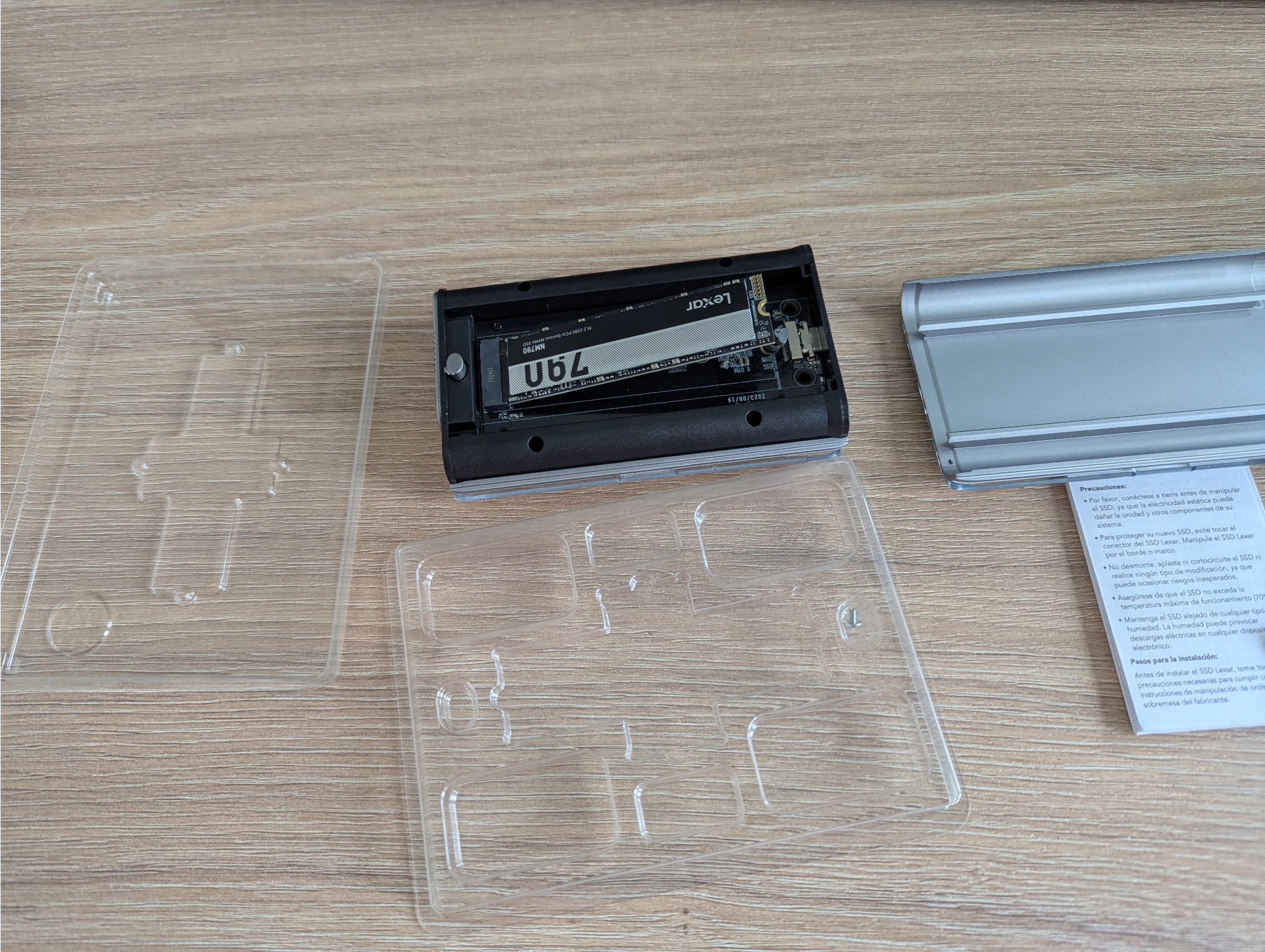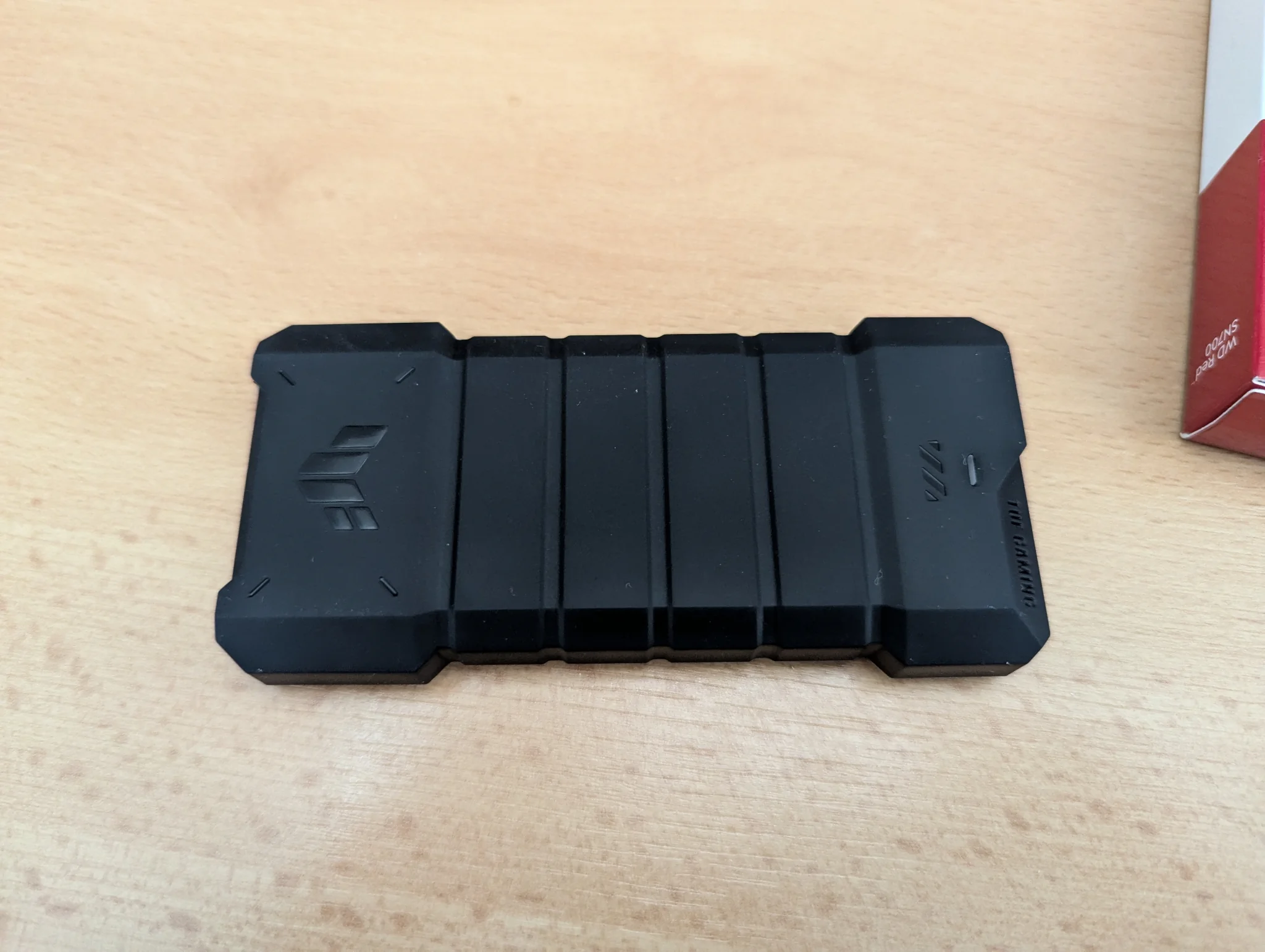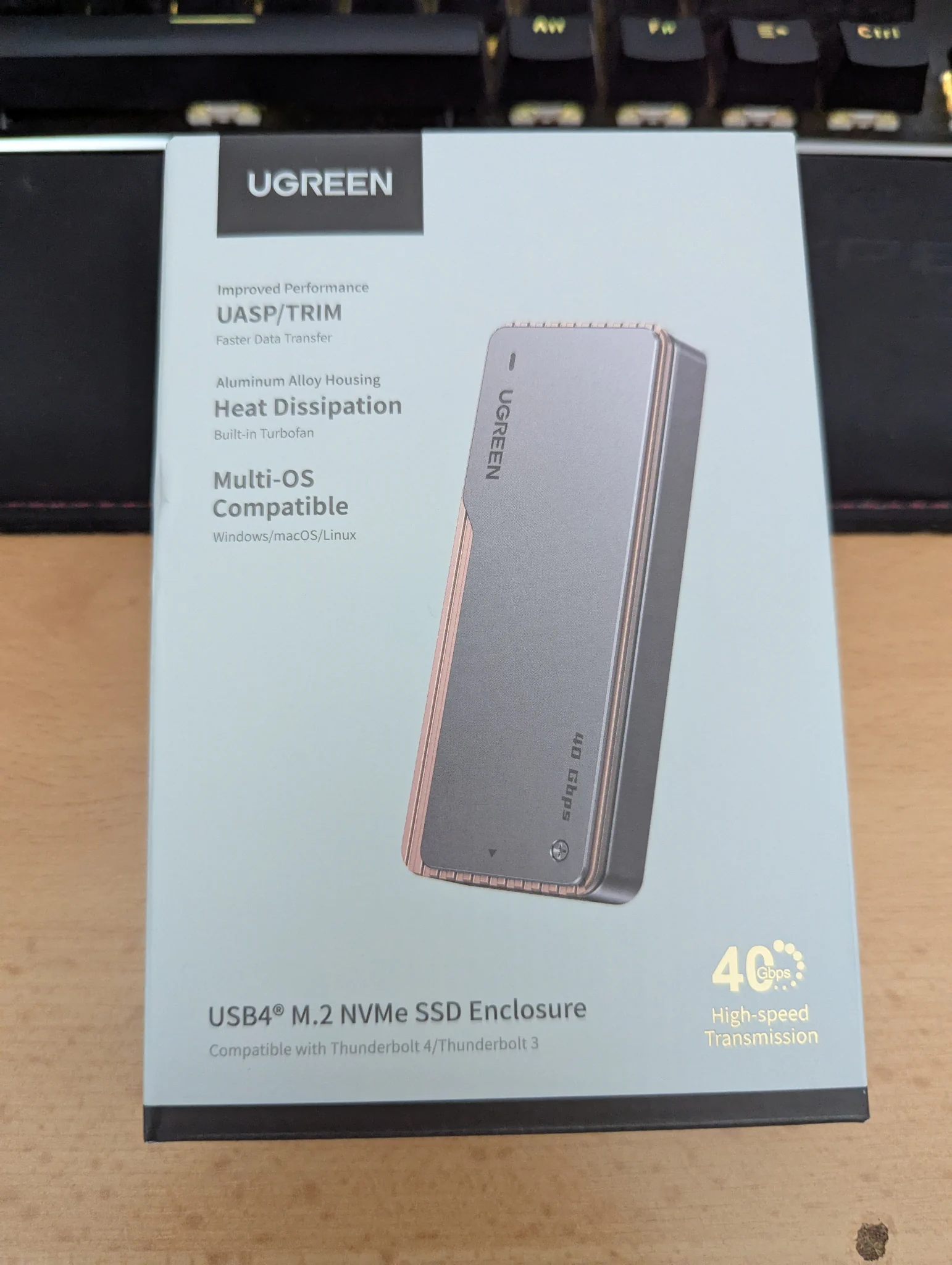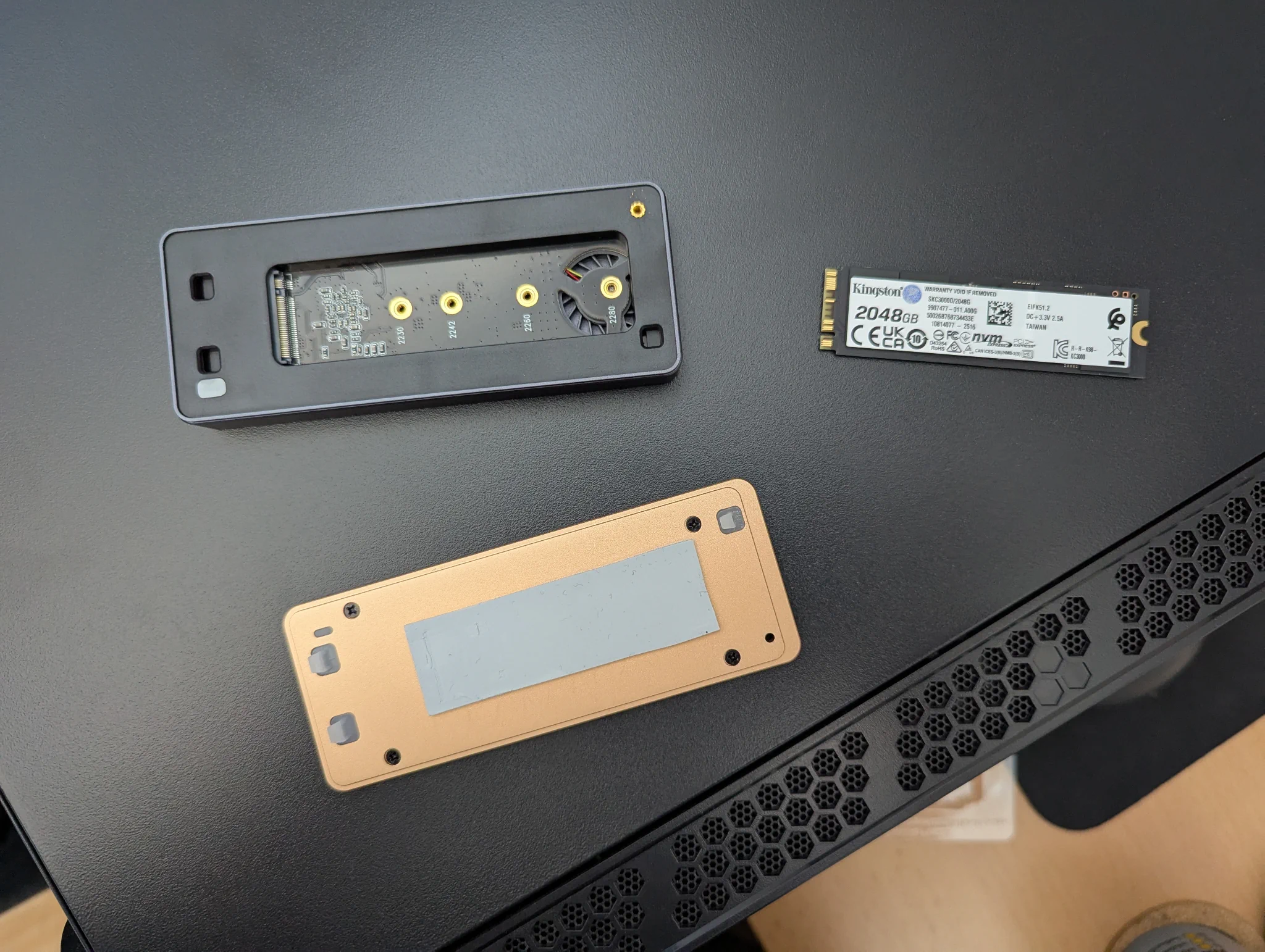Random access rants - my new USB4 enclosure

My journey for a fast & cheap external SSD had me discovering more rabbit holes, uncomfortable truths, and errors in judgement, than I would have ever wanted. I tried three enclosures and at least four SSD drives - three more than I wanted to - to arrive at a solution I am comfortable with, and works well.
Samsung Portable SSD T7 Shield - durable on the outside, fast on the inside (eventually not so much)
Two years back, I stumbled upon a flash sale on Alza that made me buy this drive in 2TB variant, for around 3000 CZK with a discount. The disk never sold cheaper on Alza than 3699 (according to hlidacshopu.cz) and now it’s priced at 5699 CZK. Basically a steal, wouldn’t you say?

Now. Let’s be clear, it’s a durable, nice-looking piece of hardware, which does deliver on its promised speeds - around 1000/1000MB per second - at least at first. The good write speeds are also described in the review at Tom’s Hardware and the drive can apparently sustain them throughout the whole capacity.
Unfortunately, over a year, maybe a year and a half of quite serious use, including a lot of smaller files, the write speed deteriorated - from 500-950 MB/s to sometimes as low as 50 MB/s. I had issues with TRIMming the disk under Linux (I will be talking about this), but it seemed to help the situation somehow. Not for long, though. (A few days back, I was able to regain full speed, at least for a bit, by reformatting (from exFAT to NTFS), then TRIMming, and then leaving the disk rest for a while. Then, the write speeds returned back to normal. However the previous bad taste still remained.)
Since the writes started being so remarkably slow, and I was limited by the 10Gbps interface, I decided to look around. I hoped that I could assemble one that would not cost as much. And, in a way, I succeeded - with the correct components, you can buy a combination that will work as fast as the current offering in Czechia, maybe even better in some cases, and stay below the prices.
I want my own enclosure
My biggest requirement (or “want”) was to sustain high writing speed for long sequential writes. At that time, I thought that I might as well get a 4TB drive, since the 20Gbps or 40Gbps speeds would allow me to fill it up rather quickly in some specific scenarios, like backing up a large drive.
Fortunately, sites like Tom’s Hardware or TechPowerUp are doing comprehensive tests of most of the SSDs available, even if not all of them made their way into our little country.
I quickly found out that most of the consumer M.2 NVMe drives can reach high speeds for just a short period of time, since that is when they write into a pSLC cache. Then, when that cache is full, the speed sharply drops, as they need to both write to the main TLC/QLC storage, and also drain the cache.
I have therefore relented and would settle for a drive that could sustain at least 1.5 Gbps. Over time, I bought these drives:
- WD Red SN700 NVMe 4TB (~6700 CZK at the time)
- Kingston KC3000 2TB (~3600 CZK)
- Lexar NM790 4TB (~6100 CZK)
The pricing varied, but I wanted a big drive so that I could offload my data quickly, if needed.
In parallel with buying a NVMe drive, I was choosing a suitable enclosure. Given the prices, and the benchmarks with sequential writing speeds, I thought that I might just settle for 20/20Gbps. That plan, while reasonable in theory, had emmental-sized holes, and they would soon become apparent.
Furthermore, I wanted an enclosure that is sold in Czechia, or at the furthest Germany, since I would be able to import that here, and I could return it easily.
ASUS TUF Gaming A2, or “is 20Gbps achievable?”

My first choice was ASUS TUF Gaming A2, for around 1300 CZK on Alza, because it promised 20Gbps speeds over USB 3.2 Gen 2x2, and had good reviews regarding thermals. With this, I chose the WD Red SN700 NVMe 4TB, as I was impressed by the benchmarks promising sustained write performance above 1500 MB/s, and it was available for a good price (back then ~6700 CZK on Alza, now back to 9100 CZK).
Suffice to say, I was a bit muffed over both. But the ASUS enclosure was not the culprit - rather the opposite. The performance was as advertised, and while I did not get to do any longer sustained write tests, I was very satisifed with both the feel and the build quality of the device, and the thermals were acceptable.
Two things bit me:
- TRIM not working under Linux,
- speeds.
“Oh and you’re not getting TRIM because this is UAS device under Linux” among other things
One of the things I wanted to avoid with a new drive, was the inability to TRIM, or otherwise condition the drive. But my choice of an enclosure, that worked as an USB-Attached SCSI, made me regret that quite early on. Not only was I unable to see S.M.A.R.T. data of the drive, but I could not TRIM it either. At least not in Linux. Windows, turns out, had that all figured out - with the Sandisk utilities, I could see it all, and even upgrade the firmware (though I was at the latest version).
On Linux, even if I could not see the SMARTs, I at least wanted the TRIM. Turns out, that is possible, and not that hard to achieve. Apparently due to various issues with various USB disks in the past, this is not set automatically, but it is possible to assign “unmap” - the SCSI equivalent for a TRIM command - as a discard method to enable disk trimming.
This helpful blog article from Jeff Geerling explains why and how, even though it is written for Raspberry Pi. Do heed the warnings though; the steps could corrupt some incompatible drives.
As a funny side note, Windows does not support TRIM for exFAT, but I only discovered that much later. Linux does not, either.
USB4 == 40Gbps, but USB3.2 == 10Gbps?!
And now to the crucial part. I thought USB4 supports USB3.2 with 20Gbps speeds (Gen 2x2). Well, it turns out that USB4 can tunnel USB3.2, but the underlying controller on the host has to support the requested speeds. (If you want to read more on this, Benson Leung explains this on Reddit in more detail, and in other threads brings other useful information on USB4 and compatibility in general.)
And in the case of Framework Laptop 13 (AMD 7840U), the controller only supports USB3.2 Gen2x1, which is 10Gbps. So the enclosure worked, but more slowly. My desktop with AMD X870 chipset, on the other hand, does support USB3.2 Gen 2x2 (20G) on the USB4 port.
When connected to my desktop, the WD drive reached 20Gbps on both write and read in CrystalDiskMark. So that worked well. I did not run some more extensive tests at that point in time, and also on my desktop I had drives that could not keep up with writing 2GB/s (or even reading! :D) for a prolonged period of time. (Mind you, I was also probably hitting some of the restrictions and sharing PCIe lanes, which is… yuck.)
But since I wanted higher speeds in general on my USB4, I had to go with an USB4 enclosure in the end. After reading some reviews, I ordered this:
Ugreen M.2 NVMe Enclosure with Cooling Fan
from German Amazon for about EUR 79, or 1950 CZK. Model is CM642, PN 15976.

And here came my disappointment with the WD drive itself. It reached 20Gbps in CrystalDiskMark, but only a few times, and after that, I have never gotten over 1280 MB/s. Real-world NTFS write speeds capped on around 700 MB/s, however, and after a minute or two, the disk throttled to 300 MB/s. All in the enclosure.
I thought that this was an issue with the enclosure, so I contacted Ugreen support. They suggested enabling write cache, which did not help.
But then I put the disk into my desktop, and what a surprise - no throttling! But the drive still kept at its low speeds and would not go higher. Admittedly, it could do that safely and the sequential speed around 1100-1200 MB/s was sustainable throughout the whole drive. And maybe, had I left it alone for a while, it might have cleared up its pSLC cache and the speeds would return.
Alas, the dropping speeds in the enclosure indicated that the USB4 bridge itself (ASM2464PD in this case) was likely overheating and the little cooling fan could not keep it cool. I had my suspicions basically confirmed by some Reddit users, but I did not want to pry the enclosure open to put a heatsink on.
Another drive

Then I bought the Kingston KC3000 2TB drive, to try that one out - with sequential write speeds at 5GB/s for a good while and then 1.5GB/s for the rest. At least that’s what the benchmarks said! Much to my bewilderment, I did already have such a drive – and funnily enough, the chipset used was different! (Yay, two different hardware revisions, how noice.)
What I had not noticed, however, was that I just bought the biggest power hog in the universe - with maximum power draw around 9 W, this disk was making the enclosure go incredibly hot, and after a while of writing, the enclosure suddenly disconnected itself. After reconnecting, the disk would no longer be recognized, neither in my Linux nor Windows machine. Furthermore, I was not able to format the drive, even when I saw the drive. Thankfully, when put in the desktop, the drive functioned normally.
I did some more experiments with another drive, Apacer AS2280Q4U, where it transpired that this drive worked in the enclosure just fine. But the enclosure was getting really hot, the speeds were dropping, and ultimately the controller was disconnecting from the system after a few minutes of load. Unknowingly, this drive was also rated for 9 W max. F*ck me.
Anyway, the enclosure was not working as it should. It could have been a firmware bug, and I thought about flashing it for a while. Since I found no official firmware release, I turned to the forums, and found a few, which could be flashed - I could even rewrite the product codes, because the tool allowed that. Upon further thinking, I reasoned against it, and returned the enclosure.
Satechi and the final solution
I bought Satechi USB4 NVMe SSD Pro enclosure.
On Alza, it cost me around 3000 CZK at first (used). Then I got some benefit discounts and I actually returned that and bought a new one for 2400 CZK (!). Yeah, Alza must love me by now. Anyway, the problem of heating was solved much better here, with ribbed aluminium case, and a plastic clip-on case, which would shield one from the heat.
The Kingston disk did not work any better in this enclosure, and finally here, in the FAQ, I discovered that double-sided SSDs are not supported. Bummer. But as I wanted to upgrade the SSD in my desktop anyway, I kept the disk.
Dual-sided SSDs not supported?
Yeah, and here’s one reason why: They are hot, and the cooling on these things only really works on one side, while it’s further heated on the other by the enclosure controller chip. I doubt that’s the only issue, but after cooling down, I was able to use the drive again, for a short while anyway.
This was an issue particularly with Kingston KC3000 2TB, and this drive was particularly unusable in the enclosures, more than any of the other I have tried. After I put that drive into my desktop, it worked again with no issues or throttling.
The symptoms were actually quite funny - I was unable to write to the drive, or format it, or even see it in the system. The drive controller was available, but I did not see the underlying storage.
The final disk - Lexar NM790 4TB

To prevent throttling, I wanted to buy a fast NVMe drive with as low power consumption as possible. From the top performers at Tom’s Hardware, I surmised that Lexar NM790 4TB might be the disk, as it was one-sided, and maximum consumption should be only 4.1 Watts! Furthermore, sustained write speeds were supposed to be really good - around 2300 MB/s for the most of the disk, and after filling 80 % of the drive, dropping to ~900 GB/s, which would still be excellent!
Alza did not have it, but Mironet did, for around 6100 CZK. So I thought, why the hell not.
And that proved to be the final solution for me - the Satechi enclosure is excellent in sustained performance, and it cools down the Lexar without any issue. The aluminium case gets hot, but the plastic case helps with that as well. Max temperatures were around 67 °C from the drive sensors. My own tests confirmed the sustained write speeds, as I rewrote the whole disk in one fell swoop, and the speeds were just where I was expecting them.
Single-threaded disk I/O is the issue now xD
Granted, in real-world file copying, I almost never got to the 2 GB/s, unless running synthetic tests. The iostat was showing that the drive was writing at 1 GB/s, but the utilization was around 25-30%. The system was slacking and could take more.
Surprise, surprise, I was now limited by the CPU! Especially with large files, the file managers are copying with single thread! When multiple copy operations were running at once, the speed was suddenly going up, and the promised 2 GB/s were possible. The drive itself has 16 operation queues, which, for my use, would probably be more than enough.
This still needs testing on Windows - it could utilize the disk better.
Cable lottery
The cables included with the enclosures have proved to be a bit of a hit and miss.
Packed with the TUF Gaming A2 was a short, sturdy USB-C cable that promised USB3.2 20Gbps capabilities. It was, however, somehow faulty: with the laptop, frequent disconnections occurred, and with the desktop, I only got 20Gbps one way. I changed the cable for my USB4 20Gbps cable, and suddenly all the issues have disappeared.
The UGreen and Satechi cables were better, where I got the best feeling from the Satechi cable, as it was not bent uncomfortably in any way, while Ugreen’s cable was packed very tightly. However, they both allowed me to reach USB4 40Gbps speeds reliably.
Framework laptop - USB4/TB3 is your (un)reliable (foe|friend)
The disadvantage of being at the bleeding edge is that sometimes things go wrong, and sometimes your hardware fails you. And this is the last remaining issue, that remains unresolved (as of the time of writing - August 2025), and that is USB4 on Framework Laptop 13 with AMD Ryzen 7840U, under Arch Linux.
Sometimes, it just connects the drive once and then never again. It gets resolved for a while if I make the computer go to sleep and then wake it up. Then I get one more connection. I can repeat this all night! There comes a time, however, when even my TB4 dock starts having issues, particularly connecting a display, and a sleep is not enough to resolve them. At that point, only reboot helps.
When I tried it with Windows, I did not have theses issues, so it is probably some ochibka in the drivers, or the EC. But I could not try it for a longer time period, so I really cannot say where the issue lies.
Hopefully, as with the amdgpu issues (and there were many!), this will eventually be resolved.